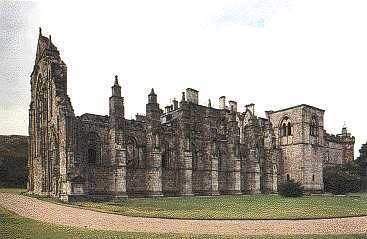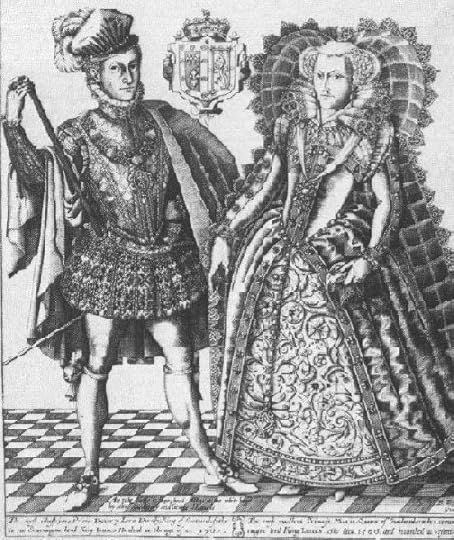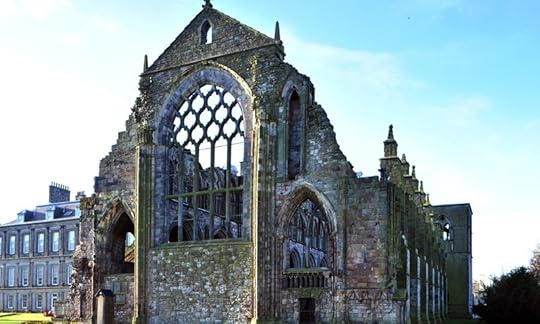The History Book Club discussion
BRITISH HISTORY
>
HOLYROOD ABBEY
date newest »
newest »
 newest »
newest »


The most famous wedding of all to take place in Holyrood Abbey was that of the twenty-two year old Mary, Queen of Scots, to the nineteen year old Darnley on 29th July 1565. Darnley placed three rings on Mary's finger and knelt beside her while the catholic priest said prayers for their union. Darnley, whose vacillating religious beliefs were notorious, was Protestant at the time and left Mary in the private chapel of Holyrood to hear Mass. Mary was dressed in black mourning to represent the widow's life she was leaving behind. After the ceremony she was divested of her mourning clothes and robed in a brightly coloured, jewel-encrusted outfit. A trumpet fanfare accompanied the couple's procession to the Great Hall where a sumptuous feast awaited them. Crowds cheered outside throwing gold coins, while Mary and Darnley were being entertained with a masque and a dance. Atholl, Morton, Crawford, Eglinton, Cassilis and Glencairn were present at the banquet to attend the couple. These festivities continued for the following two days, but he euphoria was of short duration, as Mary soon realised that she had married a complete waster.

 King David I of Scotland
King David I of ScotlandA short biography of the monarch who founded Holyrood Abbey.
David I was born circa 1080 at Dunfermline, the youngest son of Malcolm Canmore and St. Margaret. David's father and eldest brother Edward were killed at Alnwick Castle in 1093, whilst launching an invasion of Northumberland. His mother died a few days later. David, along with his brothers Edgar and Alexander were present at their mother's death at Edinburgh Castle, whilst being besieged by their paternal uncle, Donald Bain in alliance with his other brother, Edmund.
David was sent to England to join his sisters, Edith and Mary, when he was nine years old. His sister Edith was to become Queen of England through her marriage to King Henry I, while Mary was to marry Eustace of Boulogne and became the mother of King Stephen's Queen, Matilda of Boulogne.
Malcolm III and David IIDavid spent over thirty years of his life in England, he was married to a Norman heiress Matilda, daughter of Waltheof, Earl of Northampton and in her right became Earl of Huntingdon, the marriage produced two sons, Malcolm and Henry.
On the death of his elder brother King Edgar, David was given the title Earl of Cumberland and made virtual ruler of southern Scotland. He succeeded as King of Scots in 1124 on the death of his brother Alexander I.
David was destined to become the most remarkeable and memorable of the sons of Malcom Canmore. On returning to his kingdom, the new King distributed estates amongst his Norman associates, the families of de Bruce, de Comines, de Balliol and Fitz Alan (who were to be the ancestors of the Stewart dynasty) He established a new French speaking Anglo-Norman aristocracy, who were eventually to intermarry with the old Celtic nobility.
Following the example set by his saintly mother, the pious David founded many new bishoprics and abbeys including Melrose, Kelso and Jedburgh and endowed many of the monasteries. He supported the Scottish Bishops when they refused to obey an order by Pope Innocent III to accept the supremacy of the Archbishopric of York.
Source: English Monarchs
 Warden Rachel Skelly provides the viewer a quick history and tour of the famous Abbey. Very interesting.
Warden Rachel Skelly provides the viewer a quick history and tour of the famous Abbey. Very interesting.http://www.youtube.com/watch?v=8UCObN...
 A guided tour of the Royal Mile on which Holyrood Abbey is located.
A guided tour of the Royal Mile on which Holyrood Abbey is located.A Complete Guide to Edinburgh's Royal Mile
 by Robert B. McNeill (no photo)
by Robert B. McNeill (no photo)Synopsis
From Edinburgh Castle esplanade to Holyrood Palace, this comprehensive 14, 000-word guide tells the story of Edinburgh's Royal Mile and the intriguing cast of characters associated with it.
Fascinating facts include:
* Where 300 people were burned for practising witchcraft
* The location of the most haunted Close in Edinburgh
* Where you can see poet Robert Burns' love letter
* The spot where Scotland's last public hanging took place
* Where the world's first encyclopedia was published
Other places of interest you can read about include: 1. Holyrood Park (a 650-acre highland-like landscape with three lochs and a 820-foot summit).
2. Greyfriars Bobby (his story and the location of his statue). Calton Hill (location of the National Monument and the Nelson Monument).
 The Canon Regulars founded Holyrood Abbey as well as many other historic religious sites in the UK.
The Canon Regulars founded Holyrood Abbey as well as many other historic religious sites in the UK.The Regular Canon in the Medieval British Isles
 by Janet E. Burton (no photo)
by Janet E. Burton (no photo)Synopsis:
Of all the new monastic and religious groups to settle in the British Isles in the course of the twelfth century the regular canons were the most prolific. At the heart of their existence was the vita apostolica, but even more than other such groups the regular canons became involved in active spiritual care of their communities. Perhaps as a result of this feature they also enjoyed sustained support from founders, patrons and benefactors, and new foundations continued to be made long after the main force of the expansion of the monastic orders had declined. This interdisciplinary volume brings together scholars from Scotland, Ireland, Wales and England who work on aspects of the history, culture, art history and archaeology of the regular canons in the medieval British Isles. Between them, the chapters of this book consider the regular canons in their wider historical and historiographical context, assessing their role in the religious, social, cultural, economic and political world of the medieval British Isles, and introducing new and recent research on this important religious group.
 As legend has it, King David I of Scotland was riding in the forest when an apparition of the Holy Rood (crucifix) appeared to him. He was moved to erect Holyrood Abbey in honor of his vision.
As legend has it, King David I of Scotland was riding in the forest when an apparition of the Holy Rood (crucifix) appeared to him. He was moved to erect Holyrood Abbey in honor of his vision.Legends of the Holy Rood: Symbols of the Passion and Cross-Poems
 by Richard Morris (no photo)
by Richard Morris (no photo)Synopsis:
A collection of tales and legends on the finding of the cross. Contents: Discovery of the Sacred Cross; Pe Holy Rode; The Story of the Holy Rood; Finding of the Cross; The Uplifting of the Holy Rood; How Pe Hali Cros was fundin be Seint Elaine; Exposition of the Holy Rood; Dispute between Mary and the Cross; With an O and an I; The Invention of the Holy Cross; The Exaltation of the Cross; and The Symbols of the Passion.
 Holyrood: Its Palace and Its Abbey
Holyrood: Its Palace and Its Abbey(no image)Holyrood Its Palace and Its Abbey by William Moir Bryce (no photo)
Synopsis
This book was written in 1914 and there is no GR summary of the contents. But it appears to be a history of the palace and the abbey.
 I've had the pleasure of visiting both the palace and the abbey. Sadly the abbey is in ruins now, but the palace is a fantastic place to see. I have had a keen interest in the life of Mary, Queen of Scots since learning about her in primary school.
I've had the pleasure of visiting both the palace and the abbey. Sadly the abbey is in ruins now, but the palace is a fantastic place to see. I have had a keen interest in the life of Mary, Queen of Scots since learning about her in primary school. I can't recommend a visit to the palace highly enough and be prepared for your hair to stand when you enter the room and see a gold plaque on the floor marking the exact spot where David Rizzio's body was left after being stabbed.
It really is a fantastic place where history is brought to life and I can't wait to visit it again.
Thank you for your personal story about the abbey and the palace. Your posts make the history of those places come alive.
 Holyrood and Canongate: A Thousand Years of History
Holyrood and Canongate: A Thousand Years of History(no image)Holyrood and Canongate: A Thousand Years of History by E Patricia Dennison(no photo)
Synopsis:
Originally an adjunct of Holyrood Abbey, itself founded in 1128 by David I after the king had been saved from a 'muckle hart' by the miraculous appearance of a crucifix, Canongate actually remained for a long time a separate entity from Edinburgh.This is the first book to trace the complete history of the Abbey of Holyrood and its burgh of Canongate from prehistoric times to the present day, and underlines the mixed fortunes that have characterised this part of Edinburgh. Both the abbey and the burgh were built on a narrow strip of land wedged between boggy ground. This geology and geography would impact on the lives of the people from the outset until today. By the early sixteenth century part of the abbey complex had been converted into a royal palace, and by 1600 a court precinct also existed, extending into what is now the site of Scotland's new parliament.
 Who is buried at Holyrood Abbey?
Who is buried at Holyrood Abbey?The abbey was the site of many royal funerals and interments, mostly in the east bay of the south aisle, known as the "Royal Vault". Royals originally interred here include:
King David II in 1371
King James II in 1460
Arthur, Duke of Rothesay (second son of James IV) in 1510
Madeleine of Valois in 1537
James, Duke of Rothesay (eldest son of James V) in 1541
Arthur, Duke of Albany (second son of James V) in 1541
King James V in 1542
Henry Stuart, Lord Darnley in 1567
Margaret (second daughter of James VI) in 1600
Mary of Guelders in 1463 (Mary was originally buried in Trinity College Kirk)
(Source: Royalscotland)
 Going to Scotland? This little bit of information will give you a guide of what to do at Holyrood Abbey.
Going to Scotland? This little bit of information will give you a guide of what to do at Holyrood Abbey.Overview
Walk in royal footsteps around Holyrood Abbey, founded by David I in 1128. The cloister precinct was later turned into a modern Renaissance palace – Holyroodhouse – and became the royal family’s main home in Scotland.
The abbey’s choir and transepts were lost soon after the Protestant Reformation, though the nave survived as a parish church. But it too fell to ruins after the Catholic James VII and II evicted the worshippers in 1687.
What to see and do
*Wander through the abbey nave and gardens after touring the Palace of Holyroodhouse (run by the Royal Collection Trust)
*Admire the east processional doorway, the only surviving part of David I’s original ‘monastery of the Holy Rood’
*Take in the west front of the rebuilt abbey church, one of the most impressive Gothic façades anywhere in Scotland
*View the royal vault, the final resting place of both royalty and Augustinian canons
*Visit the Abbey Sanctuary, a shop in a building dating to the late 1400s or early 1500s just outside the palace gate

(Source:historicenvironment)
The Palace of Holyroodhouse
 by Alan Bold (no photo)
by Alan Bold (no photo)
Synopsis:
The Palace of Holyroodhouse is the official home of Her Majesty The Queen in Scotland. Situated at the end of Edinburgh's Royal Mile, beside the romantic ruins of Holyrood Abbey, The Palace's atmospheric interiors have seen centuries of turbulent history, witness to conflict and ceremony, marriage and murder. Today these same rooms play host to state visits and investitures, while annual garden parties are held against the dramatic backdrop of the Salisbury Crags. 56 pages and over 120 colour illustrations.
 by Alan Bold (no photo)
by Alan Bold (no photo)Synopsis:
The Palace of Holyroodhouse is the official home of Her Majesty The Queen in Scotland. Situated at the end of Edinburgh's Royal Mile, beside the romantic ruins of Holyrood Abbey, The Palace's atmospheric interiors have seen centuries of turbulent history, witness to conflict and ceremony, marriage and murder. Today these same rooms play host to state visits and investitures, while annual garden parties are held against the dramatic backdrop of the Salisbury Crags. 56 pages and over 120 colour illustrations.
Books mentioned in this topic
The Palace of Holyroodhouse (other topics)Holyrood and Canongate: A Thousand Years of History (other topics)
Holyrood its palace and its abbey (other topics)
Legends of the Holy Rood (other topics)
The Regular Canons in the Medieval British Isles (other topics)
More...
Authors mentioned in this topic
Alan Bold (other topics)E. Patricia Dennison (other topics)
William Moir Bryce (other topics)
Richard Morris (other topics)
Janet E. Burton (other topics)
More...




http://www.youtube.com/theroyalchanne...
Holyrood Abbey is a ruined abbey of the Canons Regular in Edinburgh, Scotland.
The abbey was founded in 1128 by King David I of Scotland. During the 15th century, the abbey guesthouse was developed into a royal residence, and after the Scottish Reformation the Palace of Holyroodhouse was expanded further.
The abbey church was used as a parish church until the 17th century, and has been ruined since the 18th century. The remaining walls of the abbey lie adjacent to the palace, at the western end of Edinburgh's Royal Mile. The site of the abbey is protected as a scheduled monument.
Source: Wikipedia
http://en.wikipedia.org/wiki/Holyrood...